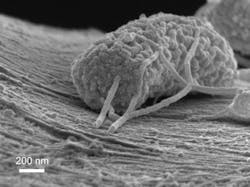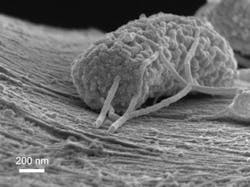Microbes Eat Sewage and Generate Electricity
Engineers at Stanford University have wired up microbes to produce electricity when they digest plant and animal waste. In the current prototype, a vial about the size of a D battery with two electrodes immersed in wastewater, a species of exoelectrogenic microbes attach themselves via electrically conductive tendrils to a carbon-filament negative electrode. (Exoelectrogenic bacteria are found in airless environments and react with oxide minerals rather than breathe in oxygen.)
As the microbes ingest organic waste and convert it to chemical fuel they can use, they also dump excess electrons out through tendrils which act as nanowires. The electrons flow to the negative electrode and across to a positive electrode made of silver oxide, a material that attracts electrons. The flowing electrons gradually reduce the silver oxide to silver, a process which stores electrons.
Within a day, the entire positive electrode is converted to silver and it gets removed from the vial and reoxidized back into silver oxide, releasing the stored electrons. The entire process extracts about 30% of the potential power locked up in wastewater as electricity. The current challenge is to find a less-expensive material to replace the silver oxide.
These so-called “microbial batteries” could be used in sewage-treatment plants to help break down sewage while generating power for the plant. Studies show that wastewater treatment consumes 3% of the total electric load in developed countries, so any reduction would make large overall savings. Treatment plants use much of that electricity pumping air into wastewater so oxygen-breathing bacteria can break down waste. The technology could also be used to get rid of pollutants in the “dead zones” of lakes and coastal waters where fertilizer runoff and organic waste deplete oxygen levels and suffocate marine life.

